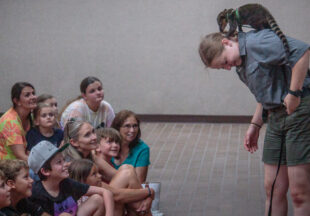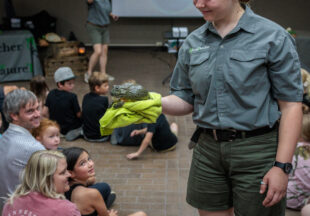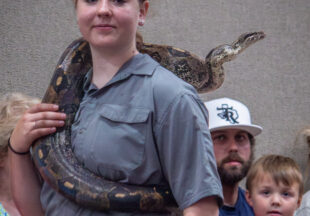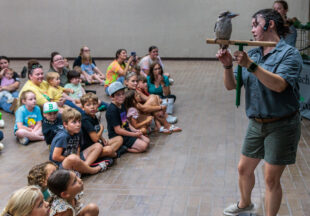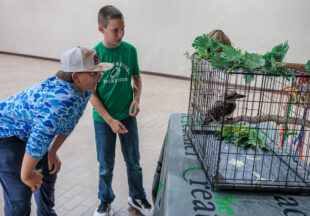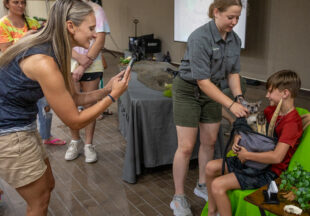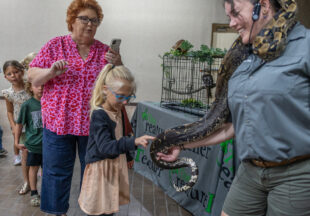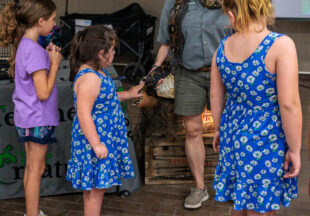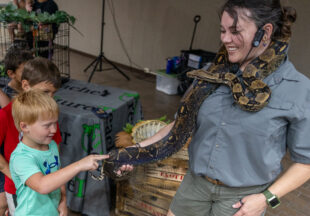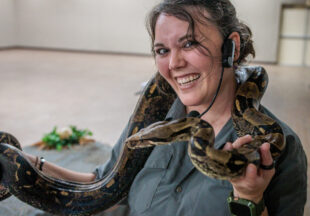Local, state officials address area’s preparedness for potential coronavirus outbreak
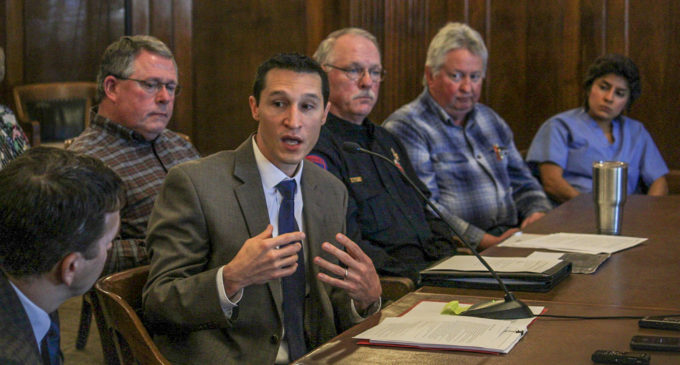
Although Stephens County and Texas are not under an immediate threat from the new coronavirus, a public meeting was held Friday morning, Feb. 28, with the local emergency management team and state health officials to provide an overview of preparedness strategies in case the situation changes.
At the meeting, local and state officials and medical professionals provided basic information about the newly discovered virus that has sickened more than 87,000 people worldwide and killed almost 3,000. There are only a few known cases of the new disease in the United States, and most of them are in patients who have been in quarantine since arriving here from China or from a cruise ship that disembarked in Japan earlier this year.
However, the most recent reports indicate that there may be some new cases in the U.S., and on Saturday, Feb. 29, the Washington State Department of Health confirmed one death from the new disease. Additionally, Washington Gov. Jay Inslee declared a state of emergency in response to new cases of COVID-19, directing Washington state agencies to use all resources necessary to prepare for and respond to the outbreak.
Throughout the United States, Texas and Stephens County, officials are working to ensure that they have plans in place to protect local residents if the disease begins to spread.
“What we’re here to do today is to network together as a community about our strategies if we ever have to face this (coronavirus),” said Stephens County Judge Michael Roach in opening the meeting.
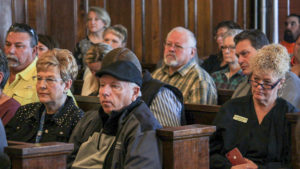
About 50 local citizens showed up to the Stephens County Courthouse on Friday morning for the emergency management team’s meeting about the local preparedness plan for a potential outbreak of the new coronavirus. (Photo by Tony Pilkington/Breckenridge Texan)
About 60 people attended the meeting in the Stephens County Courthouse, with about 50 in the audience, including local law enforcement and firefighters; medical professionals; city, county, hospital and school officials; leaders from the business community; and other interested citizens, in addition to state officials.
Roach introduced each of the guests, and Greg Goettsch, district coordinator for the Texas Division of Emergency Management in Abilene, addressed the meeting first, explaining that the office he works for supports local jurisdictions in emergencies, ranging from fires and floods to health situations, such as the coronavirus.
“The more prepared we are, the better we can combat any threat that arises out there,” Goettsch said. “I just want you to know that this is no different than any other situation we face. … We have 39 state agencies and volunteer groups at our disposal; that’s a lot of resources.”
Goettsch said the Texas Department of State Health Services is the lead on the coronavirus situation. “They understand this, medically, better than anybody else,” he said. “We have been working with TDSHS, with the CDC (U.S. Centers for Disease Control and Prevention), several federal government agencies, ever since we identified this in China, at the outset. Long before it ever made its way to United States soil, we had a lot of brilliant minds working on this thing, developing plans on how we were going to deal with it if we had a situation here in this country.
“The threat to us here in Stephens County today is extremely low, very, very low” he continued. “We’re going to make sure that stays that way. Make no mistake, though, this virus poses a very real threat.”
Dr. Joel Massey of Arlington, regional medical director for the Texas Department of State Health Services, talked to the group next, praising the officials and community members for their interest and support in tackling the potential problem. “That’s what Texas is really all about, if you think about it,” he said. “What we do best, I think, is we work together in a friendly way to overcome any adversity that comes our way. And, this is not going to be any different.”
What is the coronavirus?
Massey explained that there are many viruses in the world that affect people, animals and plants and that occasionally a virus crosses over from animals into humans.
“When this happens, sometimes because there’s no immunity in the population of human beings in the world, then that virus can start to take on and spread very quickly, again, because there’s no immunity,” he said. “The coronavirus family is a huge family of those types of viruses that affect not only humans but also animals. There are very specific species of coronavirus that are going to affect humans and that are going to affect animals. But, occasionally, one that affects primarily animals can mutate, can change, and spill over into the human population and can start taking off.”
That is apparently what happened with the new virus. Officials emphasized that although there have been viruses called “coronavirus” in the past, this is a new type of the virus that has not been seen in humans before.
According to discussions at the meeting, as well as from the CDC, the virus was first detected in Wuhan City, Hubei Province, China, and has spread to at least 59 other locations internationally, including the United States. Research indicates that the virus may have originated with bats.
Massey said that researchers are still trying to figure out exactly where it came from and how it happened, but that it is not an uncommon event in human history. “We’ve seen this happen before in human history, and many viruses have spilled over into the human population from the animal population,” he said.
There are several terms that are associated with the new virus. Many people are just calling the virus and the disease it causes “coronavirus,” but Massey specified that the virus has been named SARS-CoV-2, and the disease it causes is called COVID-19. Additionally, the virus is often referred to by the CDC and other health professionals as “novel coronavirus,” which means “new coronavirus.”
According to the TDSHS website, patients with COVID-19 have reported mild to severe respiratory illness. Symptoms can include fever, cough and shortness of breath.
Why is the new coronavirus so dangerous?
Although coronavirus is routinely seen in humans around the world, including Texas, and is a cause of the common cold, humans typically have an inherited immunity to fight off those viruses, Massey said.
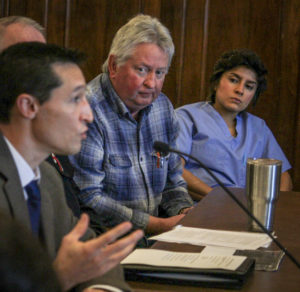
Breckenridge medical professionals Barbara Medina-Palacios, right, and Dr. William Prater, center, joined Dr. Joel Massey with the TDSHS at the local preparedness meeting. (Photo by Tony Pilkington/ Breckenridge Texan)
“But, this is a novel – meaning a new – coronavirus that we haven’t seen before,” he said. “And, because of that, we are somewhat more susceptible to more severe disease from this particular coronavirus.”
Additionally, because it is a new virus, there is no vaccine against it, and there is no known treatment for the disease, said Breckenridge’s Dr. William Prater at the meeting.
Prater explained that there are no known drugs that are effective, although the researchers are working on a vaccine and are testing current anti-viral drugs to see if any will work on the new coronavirus. “Basically, quarantine is the method of control, if it did break out,” he said.
Another issue that makes the new coronavirus dangerous is that it is spread by airborne transmission. That means that it is spread when people sneeze or cough into the air.
The TDSHS website explains that the disease is thought to be spread mainly from person-to-person. However, it may be possible for a person to get COVID‑19 by touching a surface or object that has the virus on it and then touching their own mouth, nose, or possibly their eyes, but this is not thought to be the main way the virus spreads.
Massey said that the new coronavirus is a little more deadly and able to cause more severe disease, than some of the other coronaviruses that have been seen before. “And, that’s why in China they had a very difficult time getting it under control,” he said. “Because, once you start seeing a lot of sick people, and resources are depleted from the local health care system, then how can you take care of additional sick people? Lots of resources are used, expended; people are tired. Imagine if we had an outbreak here in this small community. It would easily overwhelm the limited resources we have in the small community. And, then, where would we turn? That’s what’s happened in China, and that’s why we’re seeing such high mortality rates with this particular disease.”
Massey pointed out that 10,000 Texans die every year from flu and pneumonia, and those are illnesses for which there are vaccines against and medication to treat. “Those are things that we know very well how to treat, and yet we still have 10,000 Texans die every year from it,” he said.
Is the new coronavirus worse than the flu or other illnesses?
Massey said that the mortality rate for the new coronavirus is 2-4 percent. That rate is low, compared to ebola, which had a 70 percent mortality rate in 2014, he said.
“This is a serious illness, but we’re still not seeing the rates of death that we see with other, more serious illnesses,” Massey said.
While the new coronavirus doesn’t have as high of a mortality rate as some illnesses, the mortality rate of the flu is about .1 percent (one-tenth of one percent), making the mortality rate of the new coronavirus 20 times more deadly than the flu, according to CDC numbers.
The reason that the flu has killed more people is because more people have had the flu. Since SARS-CoV-2 is a new virus in humans, relatively few humans have contracted disease from it; therefore, few people have died from it.
At this time, because so few people have been exposed to the new virus, the risk of cornoavirus in Texas extremely low, Massey said.
Additionally, not everyone who gets COVID-19 has extreme symptoms; many just have symptoms of the common cold, he said.
How can you protect yourself and your family?
Massey, along with the CDC and the World Health Organization, recommends using the same basic methods for preventing the spread of other infections as being used to protect yourself and your family from getting the new coronavirus.
“Those are methods that you hear from Dr. Prater every time you go see him: wash your hands, make sure you’re throwing away that tissue after you use it, use the hand sanitizer,” Massey said.
During flu season, Massey said, he sometimes declines to shake hands, opting instead for a fist- or elbow-bump. “Honestly, it does help reduce the spread of disease. Again, in Texas, 10,000 of us die every year from a preventable disease, influenza,” he said.
From the Texas Department of State Health Services:
The best way to prevent infection is to take precautions to avoid exposure to this virus, which are similar to the precautions you take to avoid the flu. TDSHS always recommends these everyday actions to help prevent the spread of respiratory viruses, including:
- Wash your hands often with soap and water for at least 20 seconds, especially after going to the bathroom; before eating; and after blowing your nose, coughing, or sneezing. If soap and water are not available, use an alcohol-based hand sanitizer with at least 60% alcohol.
- Avoid touching your eyes, nose, and mouth with unwashed hands.
- Avoid close contact with people who are sick.
- Stay home when you are sick.
- Cover your cough or sneeze with a tissue, then throw the tissue in the trash.
- Clean and disinfect frequently touched objects and surfaces using a regular household cleaning spray or wipe.
- Follow the CDC’s recommendations for using a facemask: The CDC does not recommend that people who are well wear a facemask to protect themselves from respiratory diseases, including COVID‑19. Facemasks should be used by people who show symptoms of COVID‑19 to help prevent the spread of the disease to others. The use of facemasks is also crucial for health workers and people who are taking care of someone in close settings (at home or in a health care facility).
Prater added to conversation about prevention, encouraging everyone to get flu shots so that there’s less of a chance of getting the flu and thinking that it’s coronavirus.
Although many photos in the news and on social media show people wearing surgical masks, Massey said that is not really a recommended practice for protecting the average person from getting an illness. More often, the masks should be used to prevent a sick person from spreading the disease.
However, the recommendations are different for medical professionals and first responders, such as emergency medical technicians, law enforcement officers, firefighters, etc. There are protocols and protective equipment guidelines for specific situations.
Massey said that not long after it became apparent that there could be an outbreak of the new virus, various agencies experienced a slowdown in the delivery of the surgical masks. That was due, in part, to the fact that many of the masks are shipped from countries that were affected by the disease and some companies were short-handed because they had so many sick employees.
Goettsch said that there is not a shortage of masks and that the U.S. federal government put restrictions in place to prevent vendors from selling all of their masks to one department or agency, ensuring that, when needed, the masks will be available.
What else is being done to prevent the spread of the disease?
There have been some travel restrictions to people who are coming from China, and those travel restrictions mean that if a person is not a U.S. citizen or a Green Card holder or a permanent resident, then they are not permitted entry by the border patrol at ports of entry, including the ports, borders along Mexico and international airports, Massey said.
Also, officials are identifying people who have a right to be here but who have visited one of the high-risk countries that has ongoing community transmission of the coronavirus. Those people are identified and monitored by the health department, which is making regular phone calls to make sure that they are complying the department’s recommendations, including taking their temperature daily, identifying if they have any signs or symptoms of the illness, staying out of public areas. “That’s working. We’re getting a lot of compliance with that,” Massey said.
When people come in from overseas, they are screened at the airport by CDC medical officers. If someone has any signs or symptoms, such as a fever, or if they are suspected of being in contact with someone who has been ill from the new coronavirus, they will be put in federal quarantine. Massey said the officials haven’t had to do that yet, but that they are prepared to do so, if necessary.
Additionally, people who have come back to Texas from either China or from the cruise ship that had been in Japan and may have been exposed to the coronavirus or who have been confirmed to have the coronavirus, are being housed in a medical facility in San Antonio so that they are not a risk to the rest of society. They are being kept there until they are considered disease-free, meaning that they have been tested at least twice as being negative for the virus.
In the future, Massey said, there are things that officials may have to recommend or require if the disease begins to spread in the U.S., such as:
- Social distancing practices, which includes not gathering in groups at work or in other situations.
- School closures or distance learning.
- Teleworking
- Closing down social functions, such as festivals and other events.
- Staying home when you’re sick.
“We are so far from that, that that’s not really on our radar at this point. We’ve got an 89-page plan that outlines when we would do each of these types of activities,” Massey said. “So, we are not unprepared for this. The Texas Department of State Health Services has experienced outbreaks or potential outbreaks before. … We are experienced with this. We have plans, and our plans work. We are here to protect you.”
Resources
At Friday’s meeting in Breckenridge, Clint Taylor, regional preparedness coordinator for the TDSHS in Abilene, provided a list of resources for citizens, emergency managers, local government officials and medical providers.
The Texas Department of State Health Services, the U.S. Centers for Disease Control and Prevention, and the World Health Organization have web pages devoted to the new coronavirus and the disease it causes:
Local emergency management team members at the meeting included County Commissioners, Mark McCullough, Will Warren and Eric O’Dell; County Judge Michael Roach; City Manager Andy McCuistion; Mayor Bob Sims; Dr. William Prater; and Physician Assistant Barbara Medina-Palacios.
Story By Carla McKeown/Breckenridge Texan
Cutline, top photo: Dr. Joel Massey, center, regional medical director for the Texas Department of State Health Services, discusses the basics about the new coronavirus and the state’s preparedness plan for dealing with an outbreak of the disease if one occurs. Also pictured are Stephens County Judge Michael Roach; Clint Taylor, regional preparedness coordinator for the TDSHS; Greg Goettsch, district coordinator for the Texas Division of Emergency Management; Dr. William Prater; and Physician Assistant Barbara Medina-Palacios. (Photo by Tony Pilkington/Breckenridge Texan)

































